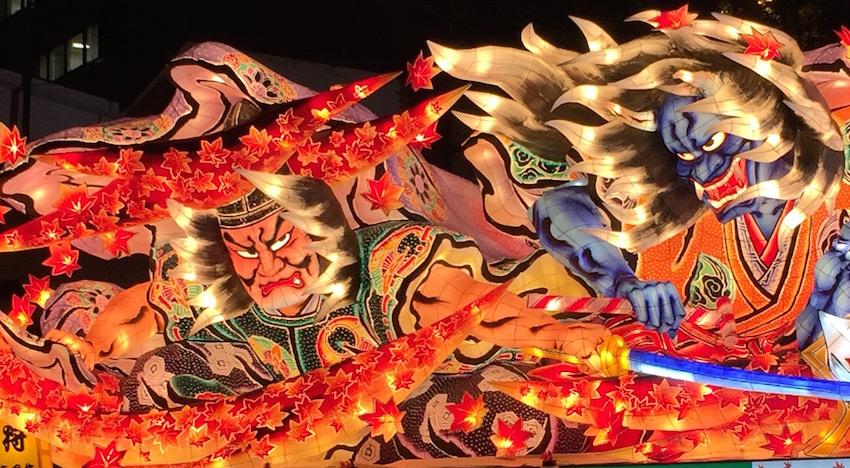夜の番人 Misawa Athuhiko ” Owl”

坂本善三 Sakamoto Zenzo「構築」"Construction” 1961-62, 、杉全直 Sugimata Tadashi 「棒a 」"Bar a" 1982 、 左官;久住有生 SAKAN;Kusumi Naomi、 三沢厚彦 Misawa Athuhiko 梟 " Owl"

坂本善三 Sakamoto Zenzo「構築」"Construction” 1961-62, 、杉全直 Sugimata Tadashi 「棒a 」"Bar a" 1982 、 左官;久住有生 SAKAN;Kusumi Naomi、 三沢厚彦 Misawa Athuhiko 梟 " Owl"

初めて青森のねぶたまつりを体感した。何の予備知識ももたずにいったのでまず山車灯籠の洗練されているのが想定外であった。ねぶた師というプロのアーティストが製作して、明かりも LED 電球がふんだんに使われているからだろうか?原色の生々しさを想像していたのだが、生々しい精気はあまり感じられず一つのショーとの印象を受けた。これも今という現実を反映しているのだろう、いろいろな要因で。それに比して秋田の竿燈まつりは生々しい精気を共感でき本来の”まつり”であった。整理してみるとビジュアル的にはねぶたまつりが勝ちかな?じつはこの東北の旅には一つの思いがあった。尺八の名手でまるで山頭火のように晩年を漂白の旅に出た伯父の終焉の地であったこと、それは終戦間もない昔のことであったが。父の元に送られた尺八とお骨、それを受け取った父の顔は子供の私に深く摺り込まれた。ラッセラの掛け声は変わらないであろう、きっと。

三島喜美代さんの「ゴミ箱」がギャラリーに来てからとんと仕事が捗らなくなった。
あれやこれやと缶並べ遊びををしていたら瞬く間に時が経つ。
それにしても空き缶(セラミック)はなんと人間臭いのだろうか?
古来日本文化には~遊びをせんとや生れけむ、戯れせんとや生れけん、遊ぶ子供の声きけば、我が身さえこそ動がるれ~梁塵秘抄(りょうじんひしょう)や禅語「遊心」が風流=芸術の根底にあります。
西洋ではホイジンガの「ホモ・ルーデンス」という遊戯が人間活動の本質であり、文化を生み出す根源だと思想があります。
私には三人の赤ん坊を育てた臨床体験が鮮明に脳裏に刻みこまれています。乳に満ち足り、寝足りた赤ん坊の行為ですがそれはそれは好奇心に溢れています。手足で遊んだり、触れるものは何でも口に持っていったり、触覚、視覚、聴覚をフル回転して一時の休みもなく遊んでいます。ハイハイができるようになるとその好奇心は一段と高まり、その好奇心により運動能力が発達していく様に見えます。
この好奇心こそ人間の本質であり asobiではないでしょうか?
さて前書きが長くなりましたが、その狙いは私の 密やかな asobiを正当化するための方便でもあるのです。
寛仁大度な作家さま方が私の“asobi”に目くじらたてられないことを願っての、
ところで、今私が目にしている作品はかってはあなたの胎内から産み出されたものですね。安産であったか、七転八倒の難産であったかはわかりませんが産み出された作品はもう一つの独立した人格?というか画格を持った生命体として存在しているのです。
そして見る者の心に生命の輝きを点火させ、時空を超えて生命のエネルギーを放出し続けるのです。
もうそれは産みの親である作家さんの圏外の事象なのです。
感動された時、もうその人のPersonal possessionになるのですから。
感動するとは一体どういうことでしょうか?
それは見者の内にある感性が呼び覚まされる、そして共鳴することではないでしょうか。見者の未窟の鉱脈を探り当てる歓喜と奏でる協奏曲こそ至宝の asobi ではないでしょうか?
References to play abound in Japanese culture passed down over the centuries. Good examples include one of the Ryojin-hisho* songs, “We are all born to play, born to have fun. When I hear the voices of children playing, my old body still responds, wanting to join in,” and the Zen word, Yushin/Asobi-gokoro (A playful mind/Playfulness). Such references indicate that play (asobi) is one of the foundations of art and the popular arts. Similar ideas can be seen in the West, such as Johan Huizinga’s Homo Ludens (or Playing Man), which discussed the importance of play as an essential element in human activity and the origin of culture.
The experience of nursing and rearing my three children is vividly imprinted on my mind. Babies who had plenty of breast milk and sufficient sleep were absolutely brimming with curiosity. They played constantly, with their senses of touch, sight, and hearing in high gear, playing with their hands and feet, and putting anything they touched in their mouths. Once they started crawling, their curiosity went up another gear, seeming to drive the development of their physical abilities and motor skills. This curiosity is surely the essence of humanity, the manifestation of Asobi-gokoro or playful mind.
Please forgive the lengthy introduction, which largely serves to justify my own furtive play. I hope my playing will not overtax the artists’ generosity and compassion. You know, the artwork that I am now looking at has come forth from your womb. I don’t know if it was an easy delivery or an excruciatingly painful, difficult delivery, but now that it is done, the work that you gave birth to exists as a separate entity with its own independent character and its own life.
That entity sparks the fire of life in the hearts of viewers, triggering the ongoing emission of life energy that will transcend time and space. What happens is already outside the control of the artist who gave birth to it. When your art moves someone emotionally, that experience becomes his or her personal possession.
What does it mean to move someone? Surely it means stirring the viewer’s emotions and resonating inside him or her.Performing a ‘concerto’ that resounds with the joy of discovering an untouched vein of something precious inside the viewer is surely the most treasured form of play.
*Ryojin-hisho (Songs to Make the Dust Dance on the Beams): a folk song collection compiled by Cloistered Emperor Go-Shirakawa in the end of Heian period. (12th century)